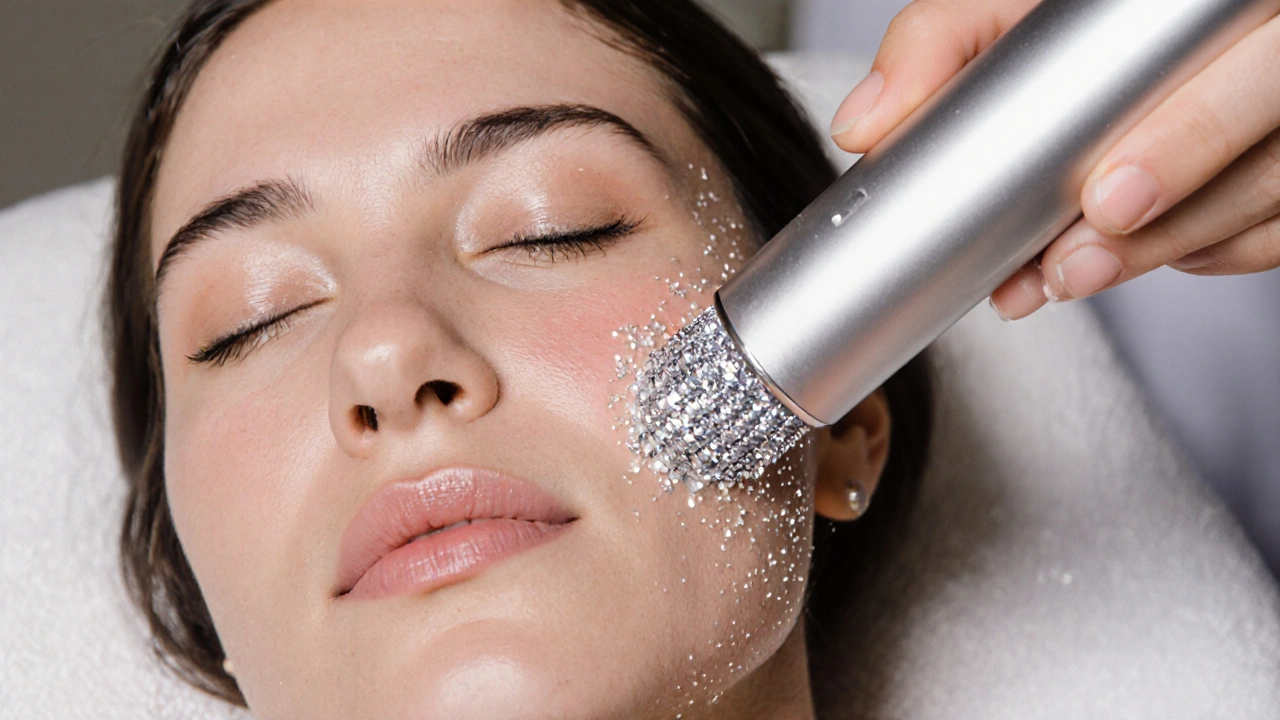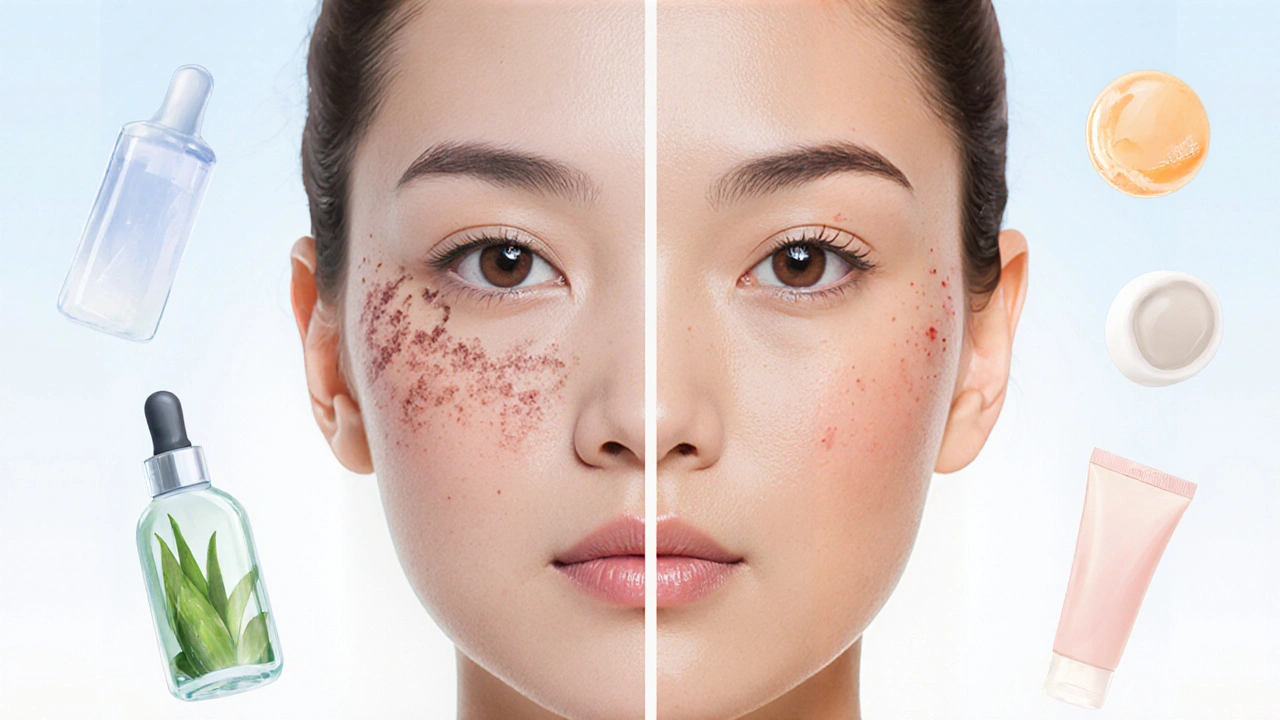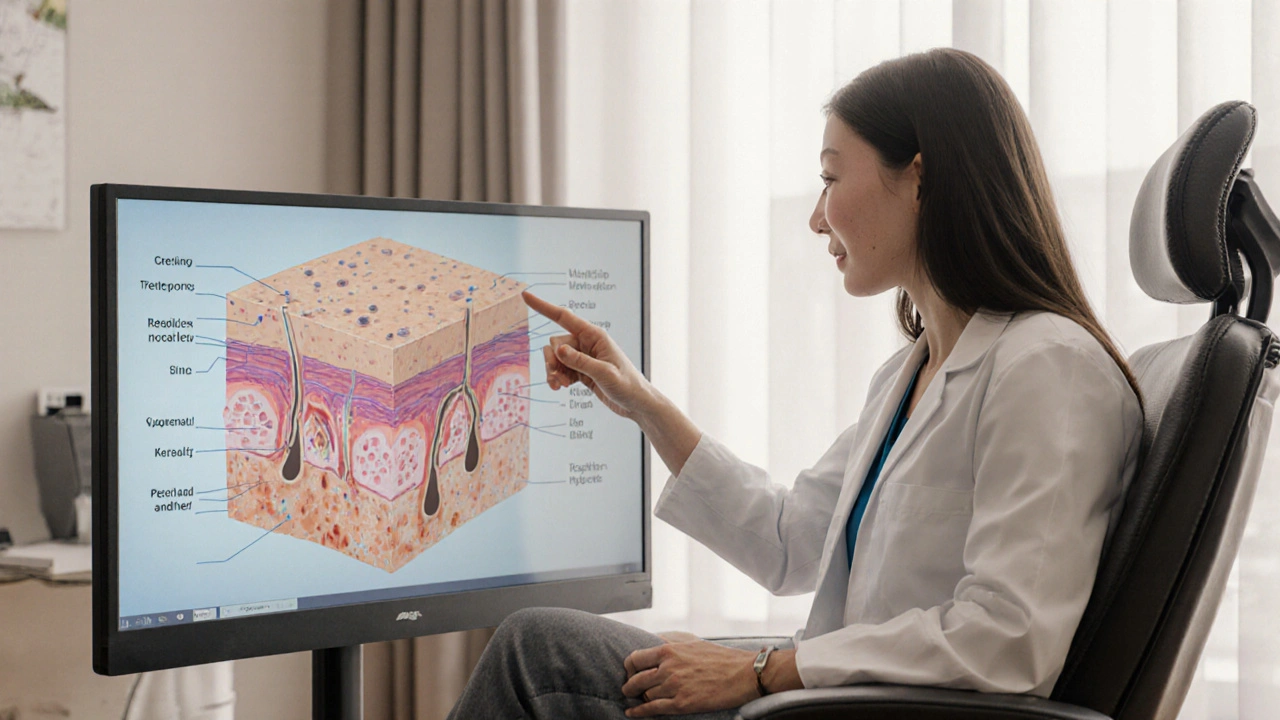Microdermabrasion Treatment Planner
Treatment Planning Calculator
Estimate the number of microdermabrasion sessions you may need based on your acne severity and desired outcome.
Your Recommended Treatment Plan
When you hear microdermabrasion is a minimally invasive exfoliation technique that uses tiny crystals or a diamond tip to gently remove the outer skin layer, you might wonder if it can actually calm stubborn breakouts. The short answer is yes, and the longer answer lies in how the treatment reshapes the skin’s surface and stimulates healing. Below you’ll learn why microdermabrasion for acne has become a go‑to option for many, what a typical appointment feels like, and how to keep your skin happy afterward.
Key Takeaways
- Microdermabrasion unclogs pores, reduces inflammation, and boosts collagen production, all of which target acne at its source.
- Sessions last 15-30 minutes with minimal downtime; most people resume normal activities the same day.
- Ideal candidates have mild to moderate acne, a healthy skin barrier, and no active infections or severe rosacea.
- Post‑treatment care-gentle cleansing, sunscreen, and occasional soothing serums-maximizes results and prevents irritation.
- When compared with a chemical peel, microdermabrasion offers a gentler approach with quicker recovery, though peels may reach deeper layers for stubborn scars.
What Is Microdermabrasion?
In simple terms, microdermabrasion is an exfoliation procedure that mechanically sands away the dead cells on the stratum corneum using fine crystals or a diamond‑tipped handpiece. The device creates a controlled micro‑injury, prompting the skin to repair itself. This repair cycle involves the production of collagen a structural protein that gives skin its firmness and elasticity and the renewal of keratinocytes cells that make up the outermost skin layer and are shed daily. By speeding up this turnover, microdermabrasion helps keep pores clear and reduces the bacterial load that fuels acne.
Why It Helps Acne
Acne thrives when dead skin builds up, pores become clogged, and inflammation spikes. Microdermabrasion tackles each of these factors:
- Unclogs pores. The crystal spray or diamond tip physically dislodges excess sebum and debris, allowing trapped comedones to surface and be removed.
- Reduces inflammation. The gentle abrasive action stimulates the skin barrier the protective outer layer that regulates moisture and guards against irritants to become more resilient, which can calm the redness associated with active breakouts.
- Boosts collagen. New collagen supports healthier skin texture, helping to flatten shallow acne scars over time.
- Improves product absorption. After the outer layer is thinned, topical acne treatments-like salicylic or benzoyl peroxide-penetrate more effectively.

What Happens During a Session
Most clinics follow a straightforward protocol:
- Consultation. A dermatologist a medical professional specializing in skin health evaluates your acne severity, skin type, and any contraindications (e.g., active eczema or severe rosacea).
- Cleansing. Your face is washed with a mild cleanser to remove makeup and surface oil.
- Exfoliation. Depending on the device, either a stream of fine aluminum oxide crystals or a diamond‑tip wand is glided across the skin. The practitioner may adjust suction strength for comfort.
- Extraction (optional). If visible comedones remain, gentle manual extraction can be performed.
- Soothing. A calming serum containing aloe or niacinamide is applied to reduce redness.
- After‑care instructions. You receive guidance on cleansing, moisturizing, and sunscreen use.
The entire process typically takes 15-30 minutes, and most people feel only a mild tingling sensation.
Recovery Time & After‑Care
Because the treatment stays within the outermost layer, downtime is minimal. You might notice a faint pink glow or slight flakiness for 24-48 hours-perfectly normal. To keep the skin calm:
- Use a fragrance‑free, sulfate‑free cleanser twice daily.
- Apply a lightweight, non‑comedogenic moisturizer containing hyaluronic acid.
- Never skip sunscreen; a broad‑spectrum SPF 30+ protects the newly exposed skin from UV‑induced hyperpigmentation.
- Avoid harsh scrubs, retinoids, or strong acids for at least 48 hours after the session.
Most patients schedule a series of 4-6 sessions spaced two weeks apart to achieve optimal results.
Who’s a Good Candidate?
Microdermabrasion works best for:
- Individuals with mild to moderate inflammatory acne or blackheads.
- People with oily or combination skin who need regular pore‑clearing.
- Those seeking a non‑chemical, low‑pain alternative to laser resurfacing.
It may not be suitable for:
- Active cystic acne that requires systemic medication.
- Severe rosacea, eczema, or open wounds on the face.
- Pregnant or nursing individuals without physician clearance.

Microdermabrasion vs. Chemical Peel
| Feature | Microdermabrasion | Chemical Peel (e.g., glycolic acid) |
|---|---|---|
| Depth of Action | Superficial (outer 0.1‑0.3mm) | Intermediate (reaches epidermis & upper dermis) |
| Typical Downtime | 0‑2 days mild redness | 3‑7 days peeling, possible swelling |
| Pain Level | Low, mild tingling | Moderate, burning sensation |
| Best For | Blackheads, mild inflammation, surface scars | Deep hyperpigmentation, thicker acne scars |
| Frequency | Every 2‑4 weeks | Every 4‑6 weeks |
Both methods stimulate cell turnover, but microdermabrasion offers a gentler approach that fits busy schedules. If you have sensitive skin or cannot tolerate peeling, the crystal/diamond technique may be the safer bet.
Pro Tips & Common Pitfalls
- Combine, don’t overdo. Pair microdermabrasion with a consistent topical regimen (e.g., salicylic acid) rather than relying on the procedure alone.
- Watch your skin barrier. If you notice excessive dryness or stinging, pause treatments and focus on barrier‑repair creams containing ceramides.
- Stay hydrated. Drinking plenty of water supports the skin’s natural healing process.
- Avoid sun exposure. UV rays can trigger post‑inflammatory hyperpigmentation after exfoliation.
- Choose a qualified provider. An experienced dermatologist or licensed aesthetician knows how to adjust suction and crystal intensity to suit your skin type.
Frequently Asked Questions
How many microdermabrasion sessions do I need to see improvement?
Most people notice clearer pores and reduced redness after 2‑3 sessions, but a full course of 4‑6 treatments spaced two weeks apart provides the best long‑term results.
Can microdermabrasion treat cystic acne?
Cystic acne usually requires oral medication or hormonal therapy. Microdermabrasion can help with the surrounding skin but isn’t a primary treatment for deep cysts.
Is there any risk of scarring from microdermabrasion?
When performed correctly, the risk is very low because the procedure stays in the superficial layer. Over‑treating or using excessive suction can irritate the skin, so it’s crucial to trust a qualified professional.
Can I use retinoids after a session?
It’s best to pause retinoids for 48 hours post‑treatment to avoid excessive irritation. After the skin has calmed, you can re‑introduce them gradually.
How does microdermabrasion differ from dermabrasion?
Dermabrasion is a surgical, deeper‑level resurfacing that removes multiple skin layers and requires anesthesia and longer healing. Microdermabrasion is a non‑invasive, surface‑only technique with no anesthesia needed.


Been doing this for 6 months now - my blackheads? Gone. Not magic, just consistent. Skip the fancy creams, just stick to sunscreen and gentle cleanser.
Okay but can we talk about how everyone acts like microdermabrasion is some new-age miracle when it’s basically just a really fancy face scrub? I get the collagen boost thing, sure, but if you’re not cleaning your pores daily with salicylic acid, you’re just wasting your time and money. I’ve seen people come in here after 4 sessions with the same clogged pores because they think the machine did all the work. Spoiler: it didn’t. Your skincare routine does. And if you’re using retinoids right after? Yeah, that’s gonna sting like hell. Don’t be that person. Also - please, for the love of all things holy, wear SPF. Your future self will thank you when you’re not trying to hide post-acne hyperpigmentation with foundation at 35.
I’m from India and we’ve been doing similar exfoliation for centuries with multani mitti and gram flour - just without the $200 machine. Microdermabrasion works, no doubt, but don’t ignore the basics: clean skin, no touching your face, and sleep. No gadget replaces that.
Look, if you’re spending $150 per session to get your skin polished like a coffee table, you’re probably not even addressing the root cause - which is usually diet or hormones. I’ve seen people with cystic acne get microdermabrasion like it’s a spa day. It’s not. It’s a Band-Aid on a broken leg. Real treatment requires prescriptions, not suction wands. Just saying.
Let’s be real - this whole ‘gentle exfoliation’ narrative is corporate BS. The industry sells you on ‘no downtime’ so you’ll keep coming back every two weeks. Meanwhile, your skin barrier is getting shredded by aluminum oxide crystals and suction that’s stronger than your ex’s last text. You think you’re ‘stimulating collagen’? Nah. You’re just creating micro-trauma so they can sell you $80 serums to ‘repair’ it. It’s a pyramid scheme with a dermatologist’s license.
Y’all are overthinking this. If you’re not getting microdermabrasion from a licensed professional in the U.S., you’re basically letting some guy in a mall kiosk sand your face with sandpaper. This ain’t yoga. It’s medicine. And if you’re from some backwater country thinking ‘gram flour’ is equivalent, you’re living in 1998. We’ve got science here. Respect it.
Just wanted to say - if you’re new to this, start slow. One session, see how your skin reacts. Don’t jump into 6 sessions like it’s a subscription. I had a bad reaction after my second one - redness that lasted 5 days. Turns out I was using a retinoid too close to the treatment. Learned the hard way. Now I just stick to hyaluronic acid and chill. It’s not about doing more, it’s about doing it right.
Ever wonder why the FDA doesn’t regulate these machines tighter? Because the beauty industry owns them. You think they want you to know that the ‘diamond tip’ is just a cheap ceramic coating? Or that the ‘crystals’ are basically industrial-grade sand? They’re not cleaning your pores - they’re just blasting off the top layer so you don’t notice the pimples underneath. Wake up. This is all placebo with a price tag.
Just wanted to add - if you have sensitive skin, go to a dermatologist, not a med spa. I tried it at a salon and my skin went nuclear. Derm said I had a mild rosacea flare-up I didn’t even know about. They caught it. Saved me from worse damage. Don’t skip the consult.
I did this once. My face looked like a tomato. I didn’t go back. Too much fuss for nothing.
Post says ‘minimal downtime’ - but if you’re going to tell people to avoid retinoids and acids for 48 hours, then technically you’re telling them to stop their entire skincare routine. That’s not minimal, that’s disruptive. And if you’re recommending ‘occasional soothing serums,’ define ‘occasional.’ Is that once a week? Twice? This article reads like a marketing brochure written by someone who’s never had acne.